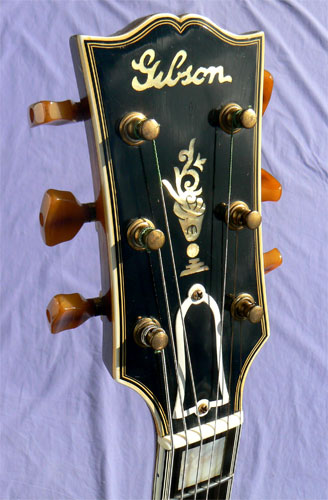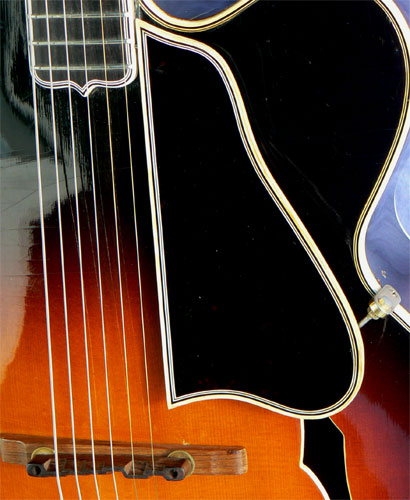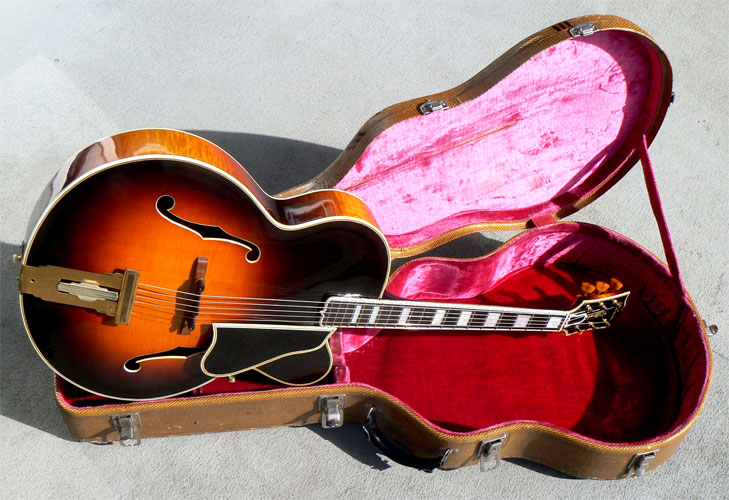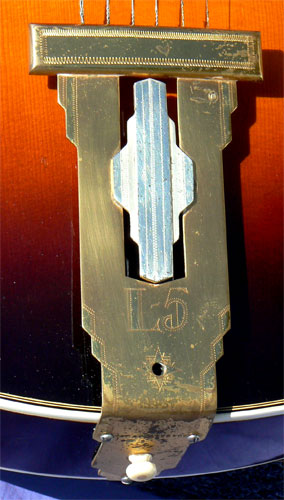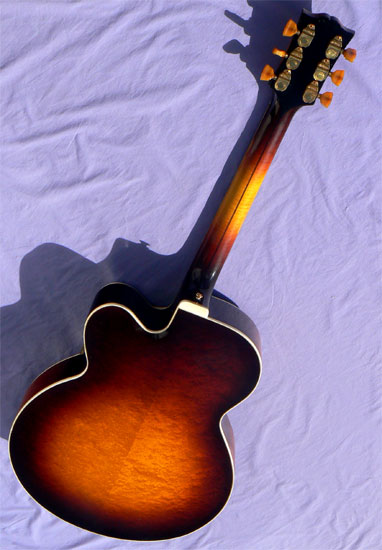
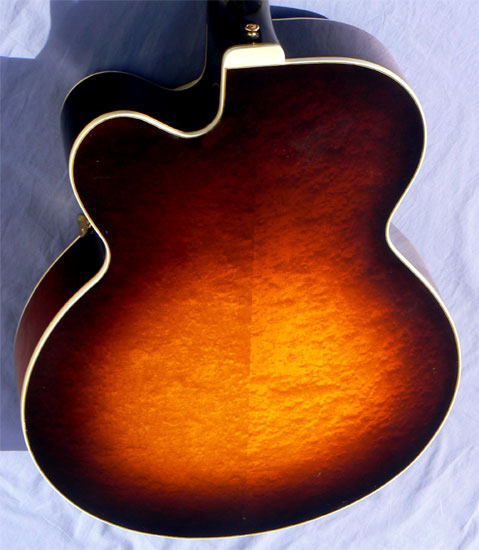
Instruments /Accessories / Ordering / Tips
archtop.com
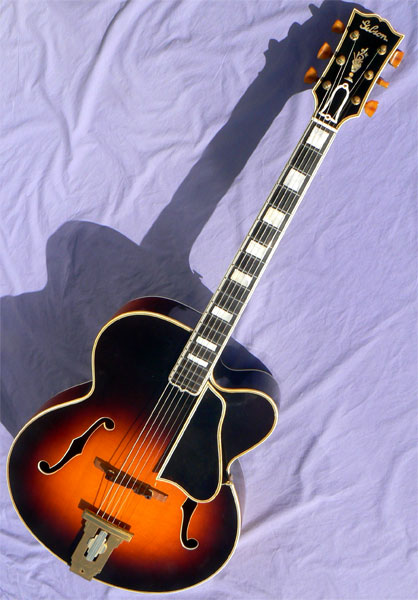
1939 Gibson L-5 Premiere
Price and Status: For pricing and hold status of this instrument, please check here. If this instrument does not appear on the Instruments page it has been sold. To be notified of examples of this or any other model in the future, please email your specific requests to [email protected].
Serial #: EA-5461 FON#: 459E-1
Body size at lower bout: 17". Scale length: 25 1/2" Nut Width: 1 11/16" Neck depth, 1st/10th frets: .87/1.01
Materials: Deeply figured solid bookmatched bubble maple back and sides; handcarved bookmatched solid spruce top; five piece flame maple neck with walnut centerstripes; quintuple bound solid ebony fingerboard with block mother of pearl inlay and pointed finial; quintuple bound peghead and body with bound f-holes; solid bone nut.
Hardware: Original gold hardware includes engraved L-5 Varitone tailpiece; Kluson Sealfast tuners with swirled amber Catalin keys; compensated adjustable Brazilian rosewood bridge. Vintage correct Mirabella bound tortoise pickguard.
Notes: Orcas Island, Washington, is just south of the Canadian border in northern Puget Sound, and part of the scenic San Juan Island chain. In the census of 1940, this remote island numbered a population of just 943 souls, in the farthest Northwest corner of the 48 states. According to the indispensable Andre Duchossoir, this gleaming guitar was dispatched October 13th of 1939 to the S.E. Philipitt Co. of Miami, Florida. Which is about as far southeast as one may travel on this continent. How this instrument made its way almost 3400 miles from one extreme of the US to the other will probably always be a puzzle. And the odds that this rarest of American guitars should surface on this tiny wooded outpost would seem as distant as the windswept island itself. But there it is.
1939 was a pivotal year for the legendary Gibson L-5. Its 'Premiere' model was the first truly modern archtop guitar, with its groundbreaking Venetian cutaway body greatly enhancing access to the upper fingerboard. That same year, Gibson returned the model to its original parallel bracing pattern, for increased projection and cutting power. By the end of '39, Gibson had shipped its first L-5P models, with a production of a mere 43 examples in sunburst finish. Premium priced over the standard L-5, the new cutaway guitars were produced in vanishingly small numbers, before production ceased altogether during WWII.
The first in its batch of 10, this historic guitar has been preserved in superb condition, over almost 80 years of splendid isolation. Carved of deeply figured bubble maple in the back, with sides of luxuriant tiger flame, the instrument has a soundboard hand graduated of old-growth spruce, quite possibly harvested not far from Puget Sound itself. The original gold hardware includes the compensated adjustable Brazilian rosewood bridge, engraved art-deco tailpiece with Gibson's new "Varitone" angle adjuster, and original gold Kluson Sealfast tuners with amber Catalin buttons, the rarest and most desirable keys fitted on any Gibson guitar.
Lovingly maintained, the instrument shows all original sunburst finish without pick or buckle wear. At just 6lb, 6oz, the guitar is happily lightweight and well balanced, with a finely carved soundboard with hand bound f-holes. The multi-ply binding is all original and tight to the body, and the gold plating is in remarkable condition, with an ornate prewar engraving pattern in the adjustable art-deco tailpiece. The neck angle and bridge height are both excellent, with smooth, low action over a remarkably contemporary, gently rounded medium 'C' profile neck, with recent pro fretwork and a fresh high-precision setup.
The finish shows a few traces of light checking, consistent with its age, and two tiny screw holes have been filled from a previously installed pickguard bracket, right next to the original, which remains in place. Apart from a few scattered lacquer nicks and scratches, and a bit of light thumbwear, the guitar looks much as it did when it left the factory almost eight decades ago: not even so much as a pickup has been installed in all those years. The voice has the silky depth and warmth the model is famed for, and the resonance and clarity of deeply aged tonewood. Completing the ensemble is its original Geib striped tweed 'aircraft cloth' case. Nestled in a thickly padded black Cordura cover, this iconic prewar case has been kept just as handsomely as the instrument itself.
It would be hard to envision an example of this most historic of Gibson archtops having survived to this day in finer condition. With graceful prewar looks, powerful performance, and a distinctly modern feel, this extraordinary guitar is an astounding find for the contemporary player or discriminating collector alike. Needless to say, we're not expecting another one soon. Call now.
Setup: Trussrod tension and neck relief adjusted; bridge height adjusted; bridge compensation strobe tuned; string slots at nut and bridge inspected and recut as necessary; bridge foot contour inspected and fit to top as necessary; bridge radius inspected and recurved as necessary; bridge wheels and tuners lubricated; fingerboard and bridge oiled; body and neck cleaned and hand polished. This instrument is strung with medium gauge nickel roundwound strings (.013-.056), and will accommodate lighter or heavier gauge strings, according to preference. String action is set at 4/64" to 5/64" at the 12th fret, with moderate relief for vigorous acoustic playing. The action may be lowered or raised to your requirements with the adjustable bridge.
Case: Original striped tweed Gibson hardshell case with pink plush lining, and padded black case cover.


